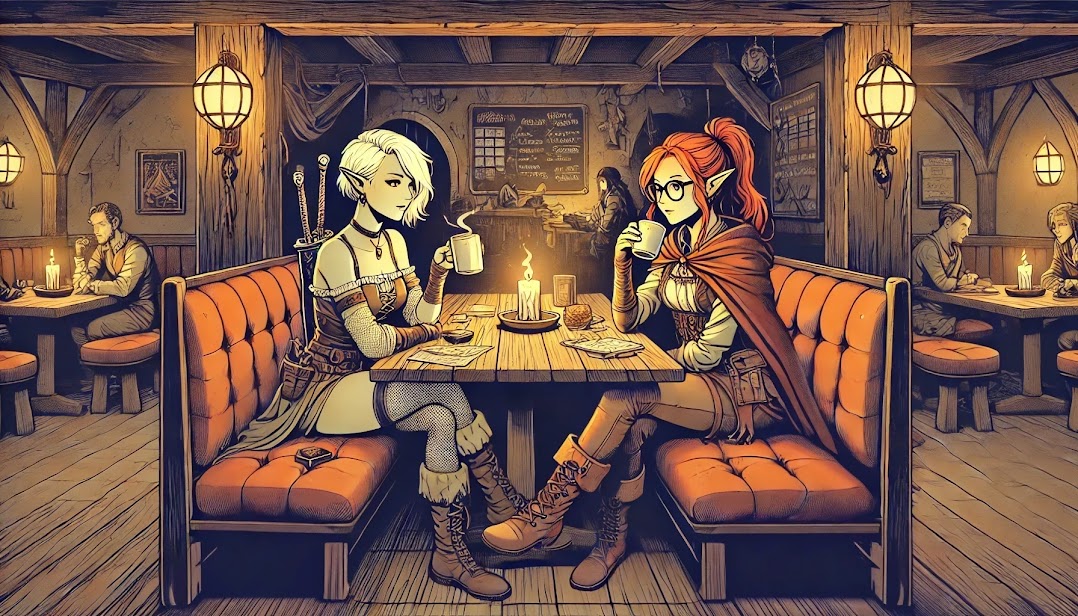Pour House
Where Most Great Adventures Begin and End
"I once had stew, cake, spiced eggs, and sweet pickles in one sitting. The cook didn’t blink. Just asked if I wanted dessert."
In the long shadow of the Arin Civil War, when the fires had cooled and the last dead were buried, Areeott entered a period not of triumph but of slow and steady healing. Fields were replanted. Roads were rebuilt. Families gathered what was left and chose to begin again. During this quiet rebuilding, a new institution quietly took root in daily life. The Pour House. It was not a tavern. It was not an inn. It carried none of the fine airs of a noble dining hall. It was something else. Something humbler, quieter, and more deeply necessary. They are not called Pour Houses because of what is poured, but because of what is offered. Soup from the ladle. Coffee from the pot. Tea, syrup, broth, stew. Hot or cold. Spiced or plain. Poured from whatever was available into whatever could hold it. The name entered the local speech almost at once. It said everything and explained nothing. Everyone in Areeott simply understood. If you were tired, or hungry, or cold, or lost, or alone, or just not ready to go home yet, the Pour House would have a seat, a plate, and no questions. These places first appeared in cities and towns. Later they spread to the highlands and the mountain passes, until even the loneliest road had at least one spot where a traveler could step inside and walk out warm and fed. They were never meant to be inns and were never mistaken for one. There are no beds. No overnight stays. But a good Pour House can feel like the center of the world. A small and steady place outside of time. It smells of coffee and grease and cinnamon. You might plan a campaign there or rest after one. Each Pour House reflects the place it serves. Some are narrow, built into stone alleys or the backs of buildings. They open to the street and are always full of noise. Others stretch out across old stables or decommissioned mess halls. The tables are uneven. The chairs do not match. They have been gathered over decades. They are always open. Always. If the door is locked or the sign turned to closed, something bad has happened and the neighborhood will already be talking. In most of Areeott, the day does not begin until the first pot is poured. There are no formal menus. What you get depends on the pantry, the cook’s mood, and what arrived on the last supply wagon. But there is always food. Something sweet. Something savory. Something starchy and filling. Something light. Something with a sharp edge of spice. The Arin understand that breakfast might be soup or steak or cake, and that is no one’s concern but your own. Some places hand out slips of vellum with house favorites listed and half the choices crossed out. Others use chalkboards. Some just call out across the room when you walk in. The rule is the same in every case. Sit down. You will be fed. Some Pour Houses expect strict behavior. You eat what is given, you pay, and you leave. Others are far looser. You can bring your own drink, your own food, your own half played game of Dragonwatch. You can play until your dice wear down. As long as you keep ordering, no one will mind. Another coffee. Another plate of hearthcakes. Another round of sweetroot sticks. These places become second homes for the ones who wander. The booth in the corner might have seen three generations of a mercenary band who met there after every campaign. That table with the scratches? Dozens of lovers have carved initials into it. Some are paired. Some crossed out. Some trail off where the hand lost heart. It is not unusual to see someone sitting alone for hours. Reading. Writing. Mending gear. Staring at the window without focus. Pour Houses make room for the in between hours of life. After the bad news. Before the apology. While you are still deciding whether to leave town or stay one more week. Some have shelves full of books. Others have old instruments tucked into corners. Some are stuffed with keepsakes and junk nailed along beams. A sword with a broken hilt. A signed portrait from a bard no one remembers. A green crystal egg that hums faintly and nobody touches. They are not temples, but they are sacred. They are not sanctuaries, but you are safe. Violence in a Pour House is rare and ends fast. Not through law or spellcraft but by the will of the people nearby. Everyone knows the rule. You do not break the peace of a Pour House. Not in front of the coffee pot. More than anything else, they are Arin. Not in the patriotic sense, but in the quiet and shared soul of a people who have suffered long and chosen, against every reason, to make something warm from the wreckage. The Pour Houses of Areeott are not praised in song or locked into national record. But they remain. A place to sit. A place to eat. A place to be. Sometimes that is enough.
Purpose / Function
"A Pour House is where you go when you don’t know where else to go. And sometimes, that’s the whole reason they exist."
The Pour House was never meant to be anything grand. Its purpose was clear from the beginning. It existed to keep people warm and fed when no other door would open. It was not born from trade or city planning. It came from need, in the quiet years that followed the war. During the Reconstruction Era after the Arin Civil War, communities needed a way to offer care without judgment or conditions. The noble houses gave protection. The temples offered prayer. But the people needed places that could give them soup, a seat, and a bit of peace. Especially for those who had nothing left. The first Pour Houses were simple kitchens built in what remained. Some opened in abandoned taverns. Others took over carriage barns or old post stations. They were run by whoever had time to cook and something to share. There were no menus. No expectations. You arrived. You ate. You left what you could. A coin. A few hours of labor. A bit of news. A quiet word. That was enough. As the years passed, their purpose stayed the same, but their place in the world grew deeper. They became part of the landscape. Not just shelter from the cold, but a steady presence in every part of Areeott and even across the border into Kestenvale. Their role has not changed. They offer comfort. They offer food. They offer a pause between whatever came before and whatever comes next. No ritual. No demand. A place for anyone. A place for no one. A place that does not ask why you came in, only what you need before you leave.
Architecture
"That table sings at night. Just a little. If it hums under your elbows, don’t worry. Means you sat where someone loved someone else real hard."
Pour Houses do not follow a single style of building, but they are easy to spot. They are shaped by use, not by pride. Their design may change from place to place, but they all share a few common traits. They are easy to enter. They feel warm. They are never formal. A real Pour House is not built to be admired. It is built to be used. If a building looks too proud of itself, it is probably not a true one. In the mountain cantons of Areeott, most Pour Houses are made from old stonework. Some are converted stables. Others are former watch posts or low halls built with Agriss granite or riverstone. The walls are thick and help hold in heat during the long winters. The beams are often bare and made from dark spruce or pine, weathered by age and fire. The roofs are steep to shed snow, covered in slate or hand cut cedar shingles. Doors tend to be oversized and often framed with old horseshoes or scraps of stove metal nailed into the wood. Each one is different, but they all carry signs of wear. Boot scrapes on the floor. Heat and water warped planks. Stains where something good once boiled over and no one cleaned it up in time. Farther south, especially in the valleys and into Kestenvale, more Pour Houses are built from wood. Poplar. Oak. Ash. They have plank floors and chimneys patched with clay and sand from the rivers. Siding is sometimes whitewashed or left plain to gray in the weather. The paint on the doors is whatever was available when the place went up. Red. Green. Ochre. None of it is for show. Still, a red door often means this place is always open and will not ask questions. People do not decorate Pour Houses with taste in mind. They leave things behind. A spear that once saved a life. A carved bit of bone. A battered hat hung on a nail. Maps stained with use. Knives etched with names. Signs in five languages saying we are open or hot stew inside. On the outside, you might find a sagging sign or a weather vane shaped like a frying pan. A stone step worn smooth by a hundred thousand boots. Nothing is meant to impress. It is all there because it matters to someone. Some of the oldest ones have grown strange over time. A second story added long after the rest. A balcony that goes nowhere. A half covered courtyard with benches pulled from an old tram. None of it is planned. The building grows as the need arises. Use shapes the place more than any blueprint ever could. The rule is always the same. Keep the kettle warm. Keep the door open. Always have a seat ready for whoever walks in.
History
"They say every Pour House has a booth that belongs to the dead. Not haunted. Just… reserved."
The first Pour Houses appeared during the early years of the Reconstruction Era. This was the quiet lull that followed the Arin Civil War, when the land was scarred but finally still. Areeott was not yet stable. Many communities had been broken. Homes were gone. Families were scattered. Entire villages had been emptied. The roads were open again, but trust had not yet returned. People needed warmth. They needed something familiar that did not ask for explanations.
At the start, these were makeshift kitchens. Hearths kept burning by widows, by retired soldiers, and by old farmers who had a little extra and no one left to share it with. They opened their doors, not to make money, but because it was the only thing that made sense. A hot plate. A place to sit. Something to drink. Something to remind you the world had not ended. Travelers started calling them Pour Houses because of the steady sound of soup or tea being ladled out into whatever cup or bowl a person brought. As the years passed and the country slowly found its footing again, the Pour House did not disappear. It became something steady. Town officials began to help in quiet ways. Trade guilds gave scrap, food, or tools. There was never a formal law to protect them, but local leaders understood. A village without a Pour House was not a place ready to live again. So they continued to spread. By the time the younger generation came of age, the ones who had not fought in the war but had grown up hearing about it, Pour Houses had become part of ordinary life. They were no longer places to go in crisis. They were places to stop between other things. Morning meals before a long hike. Late night coffee after hard news. A birthday pie served in a booth still marked by sword strikes from a war two generations past. Some Pour Houses have been open since those first postwar years without closing. Others have been rebuilt or expanded. A few have even been franchised, though rarely. But none have lost their roots. Every one of them begins with the same impulse. A door left open. A meal offered hot. A quiet refusal to turn anyone away. They are not monuments. They are not symbols of strength. They are the proof that Areeott chose to rebuild with generosity and a plain, stubborn kind of kindness.
Tourism
"One time I traded a state secret for a slice of strawberry tart and it was the best deal I ever made. Kingdom’s gone now.
Tart still haunts my dreams."
Pour Houses are not destinations in the traditional sense. They are not carved temples or grand keeps or famed battlefields. But for certain travelers, they are sacred all the same. Those who come seeking them are not tourists in the usual mold by any means. They are wanderers, nostalgists, scholars, and veterans. People who travel not to see something new, but to touch something familiar. Some travelers make a point of visiting a Pour House in every canton they pass through, collecting meals instead of trinkets. Others seek out the oldest still running establishments, looking for the legendary booths etched with names half erased by time, or the stories left behind in mismatched cutlery and cracked mugs. A few make pilgrimages to specific Pour Houses tied to family memory or personal history become enshrined as the place where a parent met a lover, where a company of adventurers swore an oath, where a wounded soldier waited out the end of the war. There’s no single Pour House aesthetic, but there is a shared experience people come to find inside. The warmth, the chatter, the soft scrape of plates and the smell of butter and starch and spice. The slow pace. The freedom to linger. Some travelers come to write, or read, or sit in silence. Others strike up conversations with strangers and add their names to the ever-growing mental ledgers kept by regulars and staff alike. Tourists who come to Areeott for the Pour Houses rarely plan their trips around accommodations. Most stay in nearby inns or boarding rooms in the area. Simple places, often within walking distance of anything interesting. The kind of quiet lodgings that pair well with a bottomless cup of coffee and an afternoon spent watching the weather change. No one stays in a Pour House, of course. That isn’t what they’re for. But those who know the culture understand that if you need a soft landing between travels, if you want to see Areeott as it truly is, you find the nearest Pour House, walk in, and take a seat like you’ve always belonged there.
"No one plans to stay long. And then it's dusk, and you're still at that same damn booth."















Comments